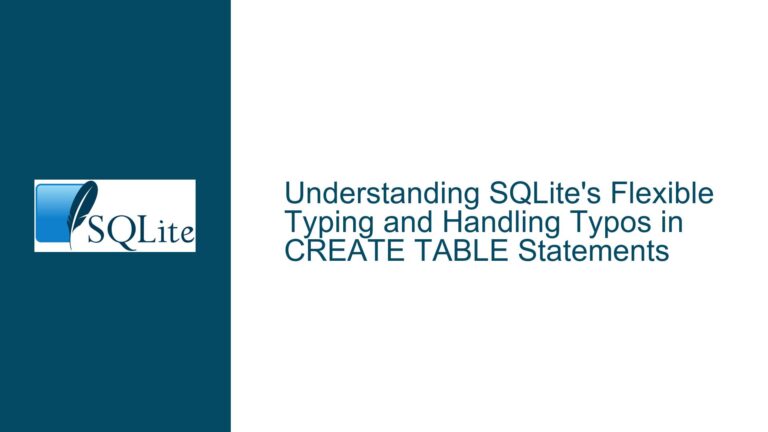Optimizing SQLite Column Ordering for Space Efficiency and Performance
SQLite Column Storage and Space Efficiency Considerations
SQLite is renowned for its lightweight and efficient design, making it a popular choice for embedded systems and applications where storage and memory are at a premium. Unlike some other relational database management systems (RDBMS) like PostgreSQL, SQLite employs a unique approach to storing data within its rows. This approach has significant implications for space efficiency and performance, particularly when it comes to column ordering.
In SQLite, rows are stored as tightly packed records with no padding or alignment between columns. This means that the order of columns within a table does not inherently affect the amount of space used on disk. Each row in an SQLite table consists of a series of values, each preceded by a type identifier. The type identifier specifies the data type of the value (e.g., integer, float, text, blob, or NULL), and the value itself is stored in a variable-length format. This design allows SQLite to minimize the amount of space used for each row, as there is no need for fixed-width columns or alignment to specific byte boundaries.
However, while column ordering does not directly impact space efficiency in SQLite, it can have indirect effects on performance, particularly when it comes to accessing and decoding data. Since SQLite must decode each value in a row sequentially to access a specific column, the order of columns can influence the amount of CPU effort required to retrieve data. For example, if a frequently accessed column is placed towards the end of a row, SQLite will need to decode all preceding columns before it can access the desired data. This can lead to increased CPU usage and slower query performance, especially for large tables or complex queries.
Impact of Column Ordering on Decoding Efficiency and Query Performance
The efficiency of decoding rows in SQLite is closely tied to the order of columns within a table. When a row is read from disk, SQLite must parse each value in sequence, starting from the first column and moving towards the last. This sequential decoding process means that accessing a column towards the end of a row requires more computational effort than accessing a column at the beginning. As a result, the placement of frequently accessed columns can have a significant impact on query performance.
For instance, consider a table with a primary key column and several large text or blob columns. If the primary key column is placed at the beginning of the row, SQLite can quickly decode and access it, allowing for efficient indexing and querying. On the other hand, if the primary key column is placed after several large text or blob columns, SQLite will need to decode these large columns before it can access the primary key, leading to increased CPU usage and slower query performance.
Similarly, the placement of large, variable-sized columns (such as text or blob columns) can affect performance. If these columns are placed towards the end of the row, SQLite can skip over them when accessing smaller, more frequently used columns. However, if they are placed towards the beginning of the row, SQLite will need to decode them even when they are not needed, resulting in unnecessary CPU overhead.
In addition to affecting query performance, column ordering can also influence the efficiency of certain operations, such as row insertion and deletion. When a new row is inserted into a table, SQLite must write the entire row to disk, including all columns. If the row contains large text or blob columns, this can result in a significant amount of data being written to disk. By placing these large columns towards the end of the row, SQLite can minimize the amount of data that needs to be written when inserting or updating rows, leading to improved performance.
Strategies for Optimizing Column Ordering in SQLite
Given the impact of column ordering on decoding efficiency and query performance, it is important to carefully consider the placement of columns within a table. While SQLite’s tightly packed storage format means that column ordering does not directly affect space efficiency, it can still have a significant impact on performance. The following strategies can help optimize column ordering in SQLite:
Place Frequently Accessed Columns at the Beginning of the Row: Columns that are frequently accessed by queries, such as primary keys, indexes, and commonly used filters, should be placed at the beginning of the row. This allows SQLite to quickly decode and access these columns, reducing CPU overhead and improving query performance.
Place Large, Variable-Sized Columns at the End of the Row: Large text or blob columns should be placed towards the end of the row. This allows SQLite to skip over these columns when they are not needed, reducing the amount of data that needs to be decoded and improving performance.
Consider Splitting Off Large Columns into Separate Tables: In some cases, it may be beneficial to split off large text or blob columns into a separate table. This can reduce the amount of data that needs to be decoded when accessing the main table, leading to improved performance. However, this approach should be used judiciously, as it can increase the complexity of queries and may not always result in a net performance gain.
Use Appropriate Data Types: SQLite’s flexible type system allows for a wide range of data types, but it is important to choose the most appropriate type for each column. For example, using an integer type for a column that will only store small integers can reduce the amount of space used and improve performance. Similarly, using a text type for a column that will only store short strings can reduce the amount of data that needs to be decoded.
Monitor and Optimize Query Performance: Regularly monitor the performance of queries and adjust column ordering as needed. SQLite provides several tools for analyzing query performance, such as the EXPLAIN QUERY PLAN statement, which can help identify bottlenecks and optimize column ordering.
By carefully considering the placement of columns within a table and following these strategies, it is possible to optimize the performance of SQLite databases and ensure efficient use of storage and memory resources. While SQLite’s tightly packed storage format means that column ordering does not directly affect space efficiency, it can still have a significant impact on performance, particularly for large tables or complex queries. By optimizing column ordering, it is possible to reduce CPU overhead, improve query performance, and ensure that SQLite databases run efficiently on a wide range of hardware and applications.
Conclusion
In conclusion, while SQLite’s tightly packed storage format means that column ordering does not directly affect space efficiency, it can have a significant impact on performance. By carefully considering the placement of columns within a table and following the strategies outlined above, it is possible to optimize the performance of SQLite databases and ensure efficient use of storage and memory resources. Whether you are working on an embedded system with limited resources or a large-scale application with complex queries, optimizing column ordering in SQLite can help you achieve the best possible performance and ensure that your database runs smoothly and efficiently.






